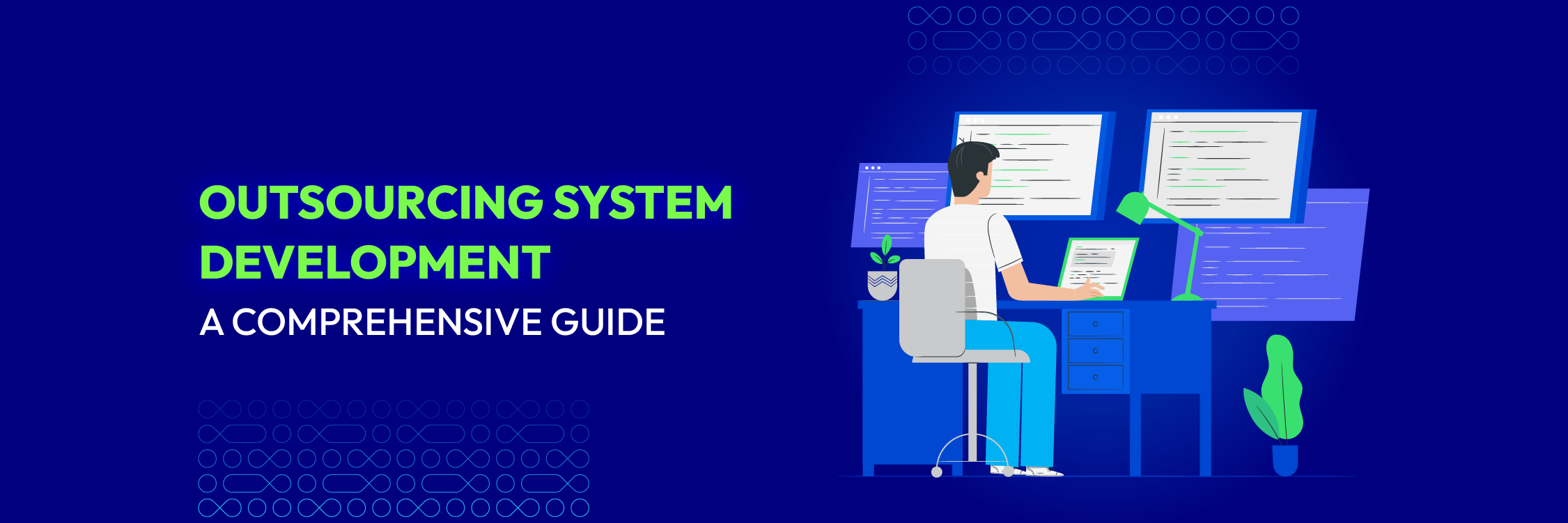Outsourcing system development: A comprehensive guide
Summer Nguyen | 01-02-2024

When your internal resources are limited, and your in-house developer teams have difficulty completing software development successfully, enlisting a specialized external partner for system development can significantly reduce the pressure your in-house team is currently encountering.
That being said, outsourcing system development is a big decision that requires careful consideration. So, if you want a comprehensive guide to outsourcing system development, this article is for you!
What is outsourcing system development?
Outsourcing system development refers to the practice of hiring external companies, often specialized in software or technology services, to design, develop, and maintain various types of systems or software applications on behalf of an organization. This can involve creating custom software solutions, web applications, mobile apps, databases, etc.
Organizations outsource system development for various reasons, such as gaining access to specialized expertise, reducing costs, accelerating project timelines, and focusing on their core business functions while leaving technical aspects to external experts.
Pros and cons of outsourcing system development

Outsourcing system development can offer several benefits, but it also comes with potential drawbacks. Here are pros and cons to consider:
- Pros:
- Access to Expertise: Outsourcing lets you tap into the specialized skills and knowledge of external professionals experienced in system development, potentially leading to higher-quality outcomes.
- Cost Savings: Outsourcing can be cost-effective when compared to an in-house development team, as it eliminates the need for salaries, benefits, office space, and equipment.
- Focus on Core Competencies: By outsourcing development tasks, your organization can focus on core functions and strategic initiatives, rather than diverting resources and attention to technical details.
- Flexibility and Scalability: Outsourcing provides the flexibility to scale your development efforts up or down based on project needs, without the constraints of hiring or laying off employees.
- Faster Time-to-Market: External teams can accelerate project timelines since they have the expertise and resources to start and promptly complete tasks.
- Cons:
- Loss of Control: Outsourcing means relinquishing some degree of control over the development process, leading to concerns about quality, security, and adherence to specifications.
- Communication Challenges: Managing remote teams can sometimes be challenging because of time zone differences, language barriers, and communication issues, potentially leading to misunderstandings.
- Security and Confidentiality Risks: Sharing sensitive business information with external parties may expose your organization to security breaches or the unauthorized use of proprietary data.
- Dependency on Third Parties: Relying on external vendors can make your organization dependent on their availability and performance, potentially impacting your project’s success.
- Hidden Costs: While outsourcing can offer cost savings, hidden expenses such as communication tools, management efforts, and potential revisions could increase the overall expenditure.
- Cultural and Workflow Differences: Differences in work culture, processes, and methodologies between your organization and the outsourced team could result in compatibility challenges.
Ultimately, the decision to outsource system development should be based on carefully assessing your organization’s needs, resources, and risk tolerance. Proper vendor selection, clear communication, well-defined contracts, and ongoing monitoring are crucial to mitigating potential downsides and maximizing the benefits of outsourcing.
Outsourcing system development models
Organizations can choose from several outsourcing models when considering system development. Each model offers a different level of control, involvement, and risk. Here are some common outsourcing system development models:

- Onshore Outsourcing: Also known as domestic outsourcing, this model involves hiring external development teams or companies within the same country as the client organization. It can help mitigate communication challenges and cultural differences while maintaining a relatively similar time zone.
- Offshore Outsourcing: Offshore outsourcing involves contracting development work to companies in different countries. This model can provide cost savings but may also introduce challenges related to time zone differences, language barriers, and cultural variations.
- Nearshore Outsourcing: Nearshore outsourcing strikes a balance between onshore and offshore models. It involves partnering with development teams in neighboring or nearby countries, which can help reduce time zone differences and foster better communication.
- Offshoring Centers: Some organizations establish their development centers in countries with a strong talent pool and favorable cost structures. This allows them to have greater control over the development process while benefiting from local expertise and reduced costs.
- Build-Operate-Transfer (BOT) Model: In this model, an organization partners with an outsourcing provider to build and operate a development center. Over time, the organization gains control and ownership of the center, transferring it to in-house management.
- Managed Services: With this model, organizations engage an outsourcing provider to manage specific aspects of the system development process, such as infrastructure maintenance, support, or application management. This allows the organization to focus on core competencies.
- Project-Based Outsourcing: Organizations outsource specific projects to external development teams in this model. The outsourcing arrangement ends once the project is completed.
- Dedicated Development Teams: This model involves hiring a dedicated team of developers, designers, and specialists who work exclusively on the client’s projects. The client has more control and ongoing involvement in the development process.
- Staff Augmentation: In staff augmentation, organizations hire additional developers or specialists to complement their in-house teams for a limited duration or specific tasks.
- Cloud-Based Development Services: Cloud providers offer development platforms and tools organizations can leverage to develop and deploy applications. This model can provide flexibility and scalability.
When selecting an outsourcing model, organizations should consider factors such as project complexity, budget, timeline, desired level of control, communication preferences, and the location of the outsourcing partner. It’s vital to conduct thorough research, and due diligence, and establish clear communication and expectations to ensure a successful outsourcing partnership
Tips to outsource system development effectively
Outsourcing system development can be a strategic move to achieve your organization’s goals, but it requires careful planning and management to ensure success. Here are some tips to help you outsource system development effectively:
1. Define clear objectives
To define clear objectives for effective outsourced software development, thoroughly analyze your business needs, project requirements, and desired outcomes.
Break down the objectives into specific, measurable, achievable, relevant, and time-bound (SMART) goals, ensuring they align with your overall business strategy. Collaborate closely with the outsourcing partner, sharing comprehensive documentation, expectations, and success criteria.
Emphasize open communication channels to clarify any ambiguities and foster a shared understanding. Regularly review and refine the objectives as the project progresses, accommodating changes when necessary while focusing on delivering a high-quality system that meets your business objectives.
2. Select the right partner
Selecting the right partner is paramount when outsourcing system development as it directly impacts project success. A suitable partner possesses expertise in the required technologies, a track record of delivering similar projects, and a cultural fit with your organization.

Begin by thoroughly assessing potential partners’ portfolios, client testimonials, and industry reputation. Engage in transparent discussions to gauge their understanding of your project’s objectives and challenges. Evaluate their communication skills, responsiveness, and ability to adapt to changing requirements. Conduct due diligence on their financial stability and security practices.
Choosing a partner who aligns with your technical needs, shares your values, and demonstrates a commitment to collaboration sets the foundation for a successful outsourced system development journey.
3. Detailed project documentation
Detailed project documentation is of utmost importance when outsourcing system development as it provides a comprehensive roadmap that guides the project’s execution, minimizes misunderstandings and ensures alignment between the client and the outsourcing team.
Thorough documentation encompasses project requirements, scope, architecture, design specifications, milestones, timelines, and communication protocols. To effectively conduct detailed project documentation, begin by engaging stakeholders from both sides to define and refine project goals and specifications. Use standardized templates and tools to capture requirements, design plans, and technical specifications.
Regularly update the documentation as the project evolves, accommodating changes and ensuring all parties have a clear reference point for decision-making, progress tracking, and maintaining project coherence.
4. Open communication channels
Open communication channels are vital when outsourcing system development as they foster collaboration, mitigate misunderstandings, and ensure project alignment. Clear and consistent communication enables prompt issue resolution, real-time progress updates, and the exchange of valuable insights.
To facilitate open communication channels effectively, establish regular communication routines such as daily or weekly status meetings, using video conferences, instant messaging, and project management tools. Define roles and responsibilities for communication points of contact on both sides.
Encourage open feedback and provide a platform for addressing concerns or changes promptly. Create a culture of transparency and encourage both parties to share challenges, solutions, and updates openly, promoting a collaborative environment that enhances the likelihood of project success.
5. Regular updates and milestones
Regular updates and milestones are pivotal when outsourcing system development by ensuring transparency, tracking progress, and maintaining project momentum. They provide tangible checkpoints for the client and the outsourcing team to assess project advancement, identify potential issues early, and make informed decisions.
To maintain regular updates and milestones effectively, establish a clear project timeline with specific milestones, each tied to deliverables or achievements. Utilize project management tools to track tasks and progress, allowing for real-time visibility. Schedule regular status meetings to review accomplishments, discuss challenges, and adjust the project plan as needed.
Encourage the sharing of interim results and prototypes to validate alignment with expectations. Consistent updates and milestones enhance accountability and communication and instill confidence in the project’s trajectory and eventual success.
6. Cultural Awareness
Cultural awareness is essential when outsourcing system development as it promotes effective collaboration, mitigates cultural misunderstandings and enhances overall project success. Recognizing and respecting diverse cultural norms, communication styles, and work practices fosters a harmonious and productive relationship between the client and the outsourcing team.

Invest time in understanding each other’s cultural backgrounds and values to create cultural awareness. Organize cross-cultural training sessions to educate team members on potential differences and sensitivities. Foster an inclusive environment where members feel comfortable expressing their perspectives and concerns related to cultural aspects.
Regularly communicate and address any cultural challenges, and be open to adapting work processes to accommodate diverse working styles and preferences, ensuring a cohesive and respectful working dynamic throughout the outsourced project.
7. Define Key Performance Indicators (KPIs)
Key Performance Indicators (KPIs) are crucial when outsourcing system development as they provide measurable benchmarks for evaluating project progress, quality, and alignment with business goals. The client and outsourcing team can track performance, identify potential issues, and make data-driven decisions by defining KPIs.
To define KPIs effectively, align them with the project’s objectives and desired outcomes. Collaboratively establish specific, quantifiable metrics that reflect critical aspects such as development speed, code quality, functionality, and user experience. Ensure KPIs are realistic and attainable, considering the project’s scope and complexity.
Regularly monitor and analyze KPI data to assess project health, and adjust KPIs if project dynamics change, ensuring that the outsourced system development remains on track and aligned with strategic goals.
8. Legal Agreements and Intellectual Property
Legal agreements and intellectual property safeguards are vital when outsourcing system development to establish clear rights, responsibilities, and protections for both parties. These agreements define ownership of code, data, and project deliverables, ensuring confidentiality, preventing disputes, and safeguarding valuable assets.
To create effective legal agreements and intellectual property protection, involve legal experts to draft comprehensive contracts that outline project scope, deliverables, timelines, payment terms, confidentiality clauses, and IP ownership. Address potential scenarios such as code reuse, modifications, and dispute resolution.
Clearly define the scope of IP ownership and usage rights during and after project completion. Regularly review and update the agreements as needed based on project progress and changes in circumstances, maintaining a solid legal foundation that safeguards interests and fosters a productive partnership.
9. Quality Assurance and Testing
Quality assurance and testing are crucial when outsourcing system development to ensure the final product meets high functionality, performance, and reliability standards. Thorough quality assurance minimizes the risk of defects and user dissatisfaction.
To conduct effective quality assurance and testing when outsourcing system development, establish clear testing requirements in the project documentation and contractual agreements.
Collaborate closely with the outsourcing team to define comprehensive test cases, including functional, performance, security, and user experience testing. Implement a structured testing process, leveraging automated testing tools to streamline repetitive tasks.
Regularly review and validate test results, fostering iterative feedback and addressing issues promptly. Maintain transparent communication channels to share testing progress, outcomes, and any necessary adjustments, resulting in a well-tested, reliable system that aligns with client expectations.
10. Change Management
Change management holds significant importance in outsourcing system development as it helps organizations navigate transitions, mitigate resistance, and successfully adopt new systems.
Effective change management begins by clearly communicating the reasons for outsourcing and its benefits. Involve stakeholders early in the process, seeking their input and addressing concerns.

Develop a detailed change management plan outlining how changes will be communicated, the training and support provided, and the strategies for managing resistance. Foster a culture of openness to change, encourage feedback, and provide ongoing support to help teams seamlessly adapt to the new system.
Regularly assess progress, gather feedback, and make necessary adjustments to the change management approach, ensuring a smooth and effective transition in outsourced system development.
11. Risk Management
Risk management is crucial in outsourcing system development to proactively identify, assess, and mitigate potential threats that could impact project success.
Effective risk management begins by conducting a thorough risk assessment involving the client and the outsourcing team to identify potential challenges, vulnerabilities, and uncertainties.
Create a risk register that outlines each identified risk, its potential impact, likelihood, and proposed mitigation strategies. Collaboratively develop contingency plans for high-impact risks and establish clear communication protocols for reporting and addressing emerging risks.
Regularly monitor the risk landscape throughout the project’s lifecycle, adapting mitigation strategies to minimize potential disruptions and ensure that the outsourced system development stays on track.
12. Regular Performance Reviews
Regular performance reviews are vital in outsourcing system development to maintain project alignment, assess progress, and address any issues promptly.
Effective performance reviews involve setting clear expectations and key performance indicators (KPIs) at the project’s outset. Schedule regular review meetings to evaluate progress against these metrics, highlighting successes and identifying areas for improvement.
Engage in open and constructive discussions with the outsourcing team, providing feedback on performance, deliverable quality, and adherence to timelines. Encourage two-way communication to address concerns, refine strategies, and make necessary adjustments.
These reviews ensure project accountability and foster a collaborative environment that enhances the overall success of the outsourced system development.
Outsource system development by Mageplaza
If you are looking for a third party responsible for your project’s software development, you can consider choosing Mageplaza software development service. When outsourcing system development by Mageplaza, you will have a team of skilled developers to help you create a powerful and feature-rich system or software applications

Mageplaza’s software development service
Numerous benefits when outsourcing system development by Mageplaza include:
- Expertise and experience: Having accumulated almost a decade of experience, Mageplaza’s committed developers possess extensive expertise in creating and adapting Magento extensions and solutions.
- Customized solutions: Each business holds its distinct characteristics. Mageplaza specializes in crafting tailor-made solutions that enhance your effectiveness, profitability, and customer contentment.
- Quality and reliability: Mageplaza is dedicated to providing clients with the utmost quality and reliability solutions.
- Transparency and communication: Mageplaza provides consistent updates and progress reports to ensure that you are well-informed and engaged throughout the software development process.
- Security: Mageplaza, a proficient software development agency, ensures robust protection for your website’s security. You can rest assured, as there is no need to be concerned about data loss or hacker attacks.
- Quality assurance: Mageplaza prioritizes quality assurance, employing meticulous testing and stringent quality control procedures to guarantee that all projects adhere to the most elevated standards.
- Flexible pricing: Put your budget concerns aside, as Mageplaza offers a range of software development packages tailored to meet your specific requirements.
The bottom line
In conclusion, outsourcing system development can be a strategic and effective approach to achieving business goals, leveraging specialized expertise, and managing costs. By following these best practices, organizations can confidently navigate the complexities of outsourced system development, harnessing the benefits of collaboration, innovation, and streamlined execution.
As the business landscape evolves, embracing the principles outlined in this guide will undoubtedly equip companies with the tools they need to thrive in a dynamic and interconnected world.





![Top 20+ Must-have Shopify Apps for 2025 [Free & Paid] - Mageplaza](https://cdn2.mageplaza.com/media/blog/must-have-shopify-apps/top-must-have-shopify-apps.png)
![[2025 Updates] Top 10+ Upsell Apps for Shopify - Mageplaza](https://cdn2.mageplaza.com/media/blog/best-upsell-shopify-app/cover.png)